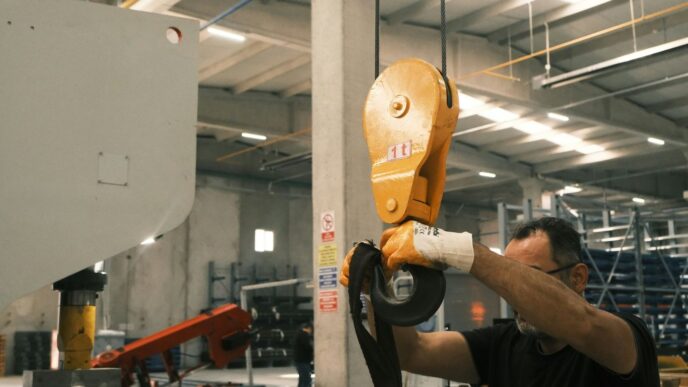Texas just passed a new law about AI, called the Responsible AI Governance Act. It’s a big deal for anyone making or using AI in the state. The original plan was pretty strict, but it got changed a lot before becoming law. Now, it focuses more on what governments can’t do with AI and sets up some interesting programs. We’ll break down what this means for businesses and what you need to know about texas ai regulation.
Key Takeaways
- The Texas Responsible AI Governance Act (TRAIGA) has been signed into law, but its scope was significantly reduced from its initial draft, focusing less on private companies and more on governmental entities.
- TRAIGA prohibits certain AI practices like behavioral manipulation and child pornography creation, but it largely removed requirements for “high-risk” AI systems that were in the original proposal.
- A new regulatory sandbox program is being established to allow companies to test AI systems in a less regulated environment for up to 36 months, with reporting requirements.
- The Texas Attorney General is the primary enforcer, with a process for consumer complaints, civil investigations, and opportunities for companies to fix violations before penalties are applied.
- Businesses can use existing risk management frameworks, like those from NIST, to help demonstrate compliance and potentially use them as an affirmative defense if a violation occurs.
Understanding The Texas Responsible AI Governance Act
So, Texas went and passed a law about AI, called the Texas Responsible AI Governance Act. It’s a pretty big deal, and it’s been through a lot of changes since it was first proposed. Initially, it looked like it was going to be super strict, kind of like what other places are doing with AI regulations. But by the time it became law on June 22, 2025, a lot of those tougher parts got dialed back, especially for private companies.
Key Provisions of the Enacted Legislation
The final version of the Act has a few main things going on. It puts some outright bans on developing or using AI for specific bad stuff. Think things like trying to manipulate people’s behavior, creating discriminatory systems, making child pornography, or generating fake videos (deepfakes) that are illegal. It also says that if you’re a government entity in Texas, you can’t use AI for things like social scoring or using biometric data to identify specific people. The Act is meant to encourage responsible AI development while also protecting people from potential AI risks. For businesses, there’s also a new program designed to let them test out AI systems in a more controlled environment. This whole thing is a big shift from the original draft, which had a much broader reach.
Shift from Original Draft to Final Act
When the bill first came out, it was modeled after some pretty serious regulations from places like Colorado and the EU. It talked a lot about "high-risk" AI systems and put a lot of responsibility on developers and companies that use AI. But, as it went through the legislative process, lawmakers made significant changes. Many of the requirements that would have made things really complicated for the private sector, like needing to do detailed impact assessments or tell consumers all about high-risk AI systems, were either removed or limited to just government agencies. This makes the current law much more focused.
Defining Artificial Intelligence Systems
Before we get too deep into what’s allowed and what’s not, it’s important to know how the Act defines "AI system." It’s pretty broad, basically saying it’s any system that uses machines to figure things out based on the information it gets. The goal is to produce outputs – like content, decisions, or recommendations – that can affect the real world or the digital one. This definition is key because it determines what kinds of technologies fall under the Act’s rules. It’s a wide net, so understanding this definition is the first step in figuring out how the law applies to different technologies and innovative AI systems.
Prohibited AI Practices Under Texas AI Regulation
So, what exactly can’t you do with AI in Texas? The Responsible AI Governance Act, or TRAIGA, lays out some pretty specific restrictions. It’s not just about general guidelines; there are actual prohibitions that developers and companies need to pay attention to. The Act aims to prevent AI from being used for harmful purposes, focusing on intent rather than just outcomes.
Categorical Restrictions on AI Development
TRAIGA puts the brakes on developing or deploying AI systems for a few key areas. Think of these as hard no’s:
- Encouraging Self-Harm or Violence: You can’t intentionally build or use AI to push people towards hurting themselves or others, or to get them involved in illegal activities. This is a pretty serious one.
- Infringing Constitutional Rights: The law prohibits AI systems designed with the sole purpose of stepping on people’s federal constitutional rights. It’s about making sure AI doesn’t become a tool to undermine fundamental freedoms.
- Unlawful Discrimination: Developing AI with the intent to discriminate against protected groups is a no-go. It’s important to note that just because an AI system might have a ‘disparate impact’ on a group doesn’t automatically mean it’s a violation. The focus here is on the intent behind the development.
- Child Pornography and Deepfakes: Creating or distributing AI systems with the specific goal of producing child pornography or unlawful deepfake videos and images is forbidden. This also extends to AI that impersonates a child under 18 in explicit text-based chats.
Intent-Based Liability for Developers
One of the more interesting aspects of TRAIGA is its focus on intent. It’s not just about what an AI system does, but what it was intended to do. This means that if a developer’s intention was to create an AI for a prohibited purpose, they could be held liable. This is a significant shift, as it places a burden on understanding the motivations behind AI creation. For businesses operating in Texas, this means carefully documenting the purpose and intended use of their AI systems. It’s a good idea to have a solid risk management framework in place to show you’re not intending to misuse the technology.
Specific Prohibitions for Governmental Entities
While the Act has broad implications, some specific prohibitions are reserved just for government entities. These include:
- Social Scoring: Government bodies can’t use AI for social scoring systems.
- Biometric Identification: Using AI to identify a specific individual based on biometric data is also restricted for governmental use.
These restrictions highlight a tiered approach to AI regulation in Texas, with certain applications deemed too risky for government use, even if private sector development in those exact areas might be permissible under different circumstances.
The Texas AI Regulatory Sandbox Program
Texas is trying something new with its Responsible AI Governance Act (TRAIGA) by setting up a special program. Think of it as a controlled environment where companies can test out their AI systems without immediately worrying about breaking every single rule. The Department of Information Resources (DIR) is in charge of this, working with the AI Advisory Council. The main idea is to let innovation happen while still keeping an eye on potential problems.
Purpose and Administration of the Sandbox
The sandbox program is designed to give developers and deployers a chance to experiment with AI technologies. It offers a sort of legal protection, allowing for limited authorization to test systems. This means companies can get their AI out there and see how it performs in the real world, under specific conditions, without the full weight of all state regulations bearing down on them. The DIR manages the program, making sure it runs smoothly and aligns with the goals of TRAIGA. This initiative is a key part of how Texas plans to handle the rapid growth of artificial intelligence, providing a pathway for new technologies to be explored responsibly. You can find more details about this regulatory sandbox program.
Requirements for Sandbox Participants
Getting into the sandbox isn’t just a walk in the park. If you want to participate, you’ll need to submit a pretty detailed application. This application has to include a thorough description of the AI system you plan to test. You also need to explain how your system is expected to benefit people and what potential risks it might have, especially concerning privacy and public safety. Mitigation plans are a big deal too – you have to show what you’ll do if something goes wrong during testing. Plus, you’ll need to prove you’re already following federal AI laws. It’s a lot, but it’s meant to ensure that only serious, well-thought-out projects get a spot.
Duration and Reporting Obligations
Once you’re accepted into the sandbox, you get a decent amount of time to work with your AI system: up to 36 months. During this period, the Texas Attorney General can’t take legal action against you for violations of the state laws that are being relaxed for the sandbox. State agencies also can’t come after you with penalties. However, this doesn’t mean you’re completely off the hook. Participants have to submit reports to the DIR every three months. These reports need to cover how the system is performing, any updates made to reduce risks, and feedback from users. The DIR then uses all this information to report back to the Texas legislature, helping them figure out what new laws or rules might be needed down the road.
Enforcement Mechanisms and Penalties
So, what happens if someone doesn’t play by the rules when it comes to AI in Texas? The Texas Attorney General’s office is the main player here. They’re the ones tasked with making sure companies and individuals are following the Responsible AI Governance Act.
Role of the Texas Attorney General
The Attorney General (AG) is pretty much the sole enforcer of this Act. They’ve got a system set up on their website, kind of like what they use for privacy complaints, where people can report if they think an AI system is being used in a way it shouldn’t be. This reporting mechanism is key for consumers to voice concerns.
Consumer Complaint Reporting
When a complaint comes in, the AG can start looking into it. If they suspect a violation, they can send out what’s called a Civil Investigative Demand. This is basically a formal request for information. They might ask for details about:
- What the AI system is supposed to do.
- What kind of data was used to train it.
- What data goes in and what comes out.
- How the system’s performance is measured and what its weak spots are.
- How the system is monitored after it’s put to use and what safety measures are in place.
Civil Investigative Demands and Cure Periods
After the AG gets a complaint and maybe sends out a demand, the company or person accused has a chance to fix things. They get 60 days to "cure" the violation. This means they have to correct the problem and then show the AG proof that they’ve done it. If they don’t fix it within that time, the AG can then take action to stop the violation.
Monetary Penalties for Violations
If a violation isn’t fixed, there are financial consequences. The penalties can vary:
- For violations that a court says could have been fixed, or if someone breaks a promise to fix something, the fines can be between $10,000 and $12,000 per issue.
- If a violation is deemed unfixable by a court, the fines jump up significantly, ranging from $80,000 to $200,000 for each violation.
- And if a violation just keeps going on, they can be fined up to $40,000 for every single day it continues.
It’s also worth noting that state agencies can get involved if a company they license is found to have violated the Act. In those cases, the AG might recommend further action, which could include suspending or even revoking a license, along with potential fines of up to $100,000.
The Texas Artificial Intelligence Advisory Council
Composition and Appointment of Council Members
The Texas Responsible AI Governance Act (TRAIGA) sets up a new group called the Texas Artificial Intelligence Advisory Council. This council is made up of seven people who are considered qualified to talk about AI. The governor, lieutenant governor, and the speaker of the house all get to pick members for this council. It’s a mix of different state leaders appointing the folks who will guide AI policy.
Council’s Role in Training and Reporting
So, what does this council actually do? Well, a big part of their job is to put together and run AI training programs. These programs are for state agencies and local governments, helping them get a better handle on how to use AI responsibly. They can also put out reports on different AI topics. Think about things like data privacy, how to make sure AI is ethical, and the legal risks involved with using AI. The main idea here is to give the Texas legislature good information so they can make smart laws about AI. They’re basically there to help lawmakers understand the ins and outs of AI.
Limitations on Rulemaking Authority
It’s important to know what the council can’t do. The Act is pretty clear that this council doesn’t have the power to create its own binding rules or regulations. They can advise, they can train, and they can report, but they can’t make laws themselves. That power stays with the legislature. They’re an advisory body, plain and simple, meant to inform policy rather than create it.
Navigating Compliance for Businesses
Okay, so Texas has this new Responsible AI Governance Act, and if you’re a business working with AI, you’ve got to figure out how to play by the rules. It can feel like a lot, especially with regulations popping up everywhere, not just in Texas but globally. Think of it like trying to follow a bunch of different road maps at once – it’s confusing.
Affirmative Defenses and Risk Management Frameworks
One of the main things the Act talks about is how businesses can show they’re trying to do the right thing. It’s not just about avoiding trouble; it’s about having a plan. The law mentions "affirmative defenses," which basically means if something goes wrong, you can point to the steps you took beforehand to prevent it. This is where having a solid risk management framework comes in. It’s like building a safety net before you start a high-wire act.
- Document Everything: Keep records of your AI development process, including data sources, testing, and any risk assessments you did. This is your proof.
- Regular Audits: Periodically check your AI systems to make sure they’re still working as intended and not causing unexpected problems.
- Clear Policies: Have written policies about how AI should be used and developed within your company. Make sure everyone knows what they are.
Leveraging Existing Governance Structures
Now, you might think you need to build a whole new system from scratch. But honestly, most companies already have some kind of governance in place, right? Maybe you have privacy policies or data security rules. The trick here is to see how you can adapt those existing structures to cover AI. It’s much easier than starting over.
Think about your current processes for:
- Data Privacy: How do you handle personal information now? AI often uses a lot of data, so your existing privacy protocols are a good starting point.
- Third-Party Risk: If you use AI tools made by other companies, you already have ways to check if those vendors are reliable. You’ll just need to add AI-specific questions.
- Product Development: Your usual product development lifecycle probably includes checks and balances. You can integrate AI risk assessments into those existing stages.
Practical Takeaways for Developers and Deployers
So, what does this all mean for the folks actually building and using AI? It means being proactive. Don’t wait for the Texas Attorney General to come knocking.
- Understand the Definitions: Know what the Act considers an "artificial intelligence system." This is key to knowing if it even applies to you.
- Identify Prohibited Practices: Be aware of the specific AI practices that are outright banned. Ignorance isn’t a great defense.
- Consider the Sandbox: If you’re working on innovative AI that might push the boundaries, look into the Texas AI Regulatory Sandbox. It’s a way to test things out in a controlled environment with some regulatory oversight.
Basically, the goal is to build AI responsibly from the ground up. Integrating these compliance steps into your daily operations will make things much smoother down the road. It’s about making sure your AI is not only smart but also ethical and lawful.
Wrapping It Up
So, Texas has stepped into the AI regulation game with the Responsible AI Governance Act. It’s not quite the sweeping overhaul some might have expected, especially compared to earlier drafts. Instead, it focuses on specific prohibited AI uses and sets up a sandbox for testing. For businesses working with AI in Texas, the key takeaway is that the law takes effect January 1, 2026. This gives everyone a bit of breathing room to get their ducks in a row. While the Act aims to protect folks and guide AI’s responsible growth, it’s clear that keeping up with these rules will be an ongoing process. It’s a good idea to stay informed as things develop and make sure your AI practices align with the new requirements.
Frequently Asked Questions
What is the Texas Responsible AI Governance Act (TRAIGA)?
TRAIGA is a new law in Texas that sets some rules for how artificial intelligence (AI) systems can be used. It’s designed to help make sure AI is developed and used in a way that’s safe and fair for everyone. Think of it like setting up guidelines to prevent AI from being used for harmful things.
What kind of AI uses are banned in Texas?
Texas law says you can’t create or use AI for really bad stuff. This includes things like tricking people’s minds, treating people unfairly because of who they are, making child pornography, or creating fake videos of people (deepfakes) that are meant to harm them. It also stops AI from messing with people’s basic rights.
What is the AI Sandbox Program?
The AI Sandbox is a special program where companies can test out new AI systems. It’s like a safe testing ground where they don’t have to worry as much about breaking some of the usual AI rules while they’re developing and checking if their AI works well and is safe. They have up to 36 months to do this testing.
Who is in charge of making sure companies follow these AI rules?
The main person in charge of enforcing these rules is the Texas Attorney General (AG). If someone thinks a company is breaking the rules, they can report it on the AG’s website. The AG can then investigate and ask for information about the AI system.
What happens if a company breaks the rules?
If a company is found to be breaking the rules, they usually get a chance to fix the problem within 60 days. If they don’t fix it, they could face big fines. Fines can be up to $200,000 for serious problems that can’t be fixed, and smaller fines for other issues. They could also have their business licenses affected.
Do businesses need to create totally new plans for AI rules?
Not necessarily! Many businesses already have ways to check for risks and make sure they’re following laws, like privacy rules. They can often update these existing plans to include AI rules. It’s better to add AI rules to what they already have instead of starting all over again. This helps save time and makes sure everything works together.














